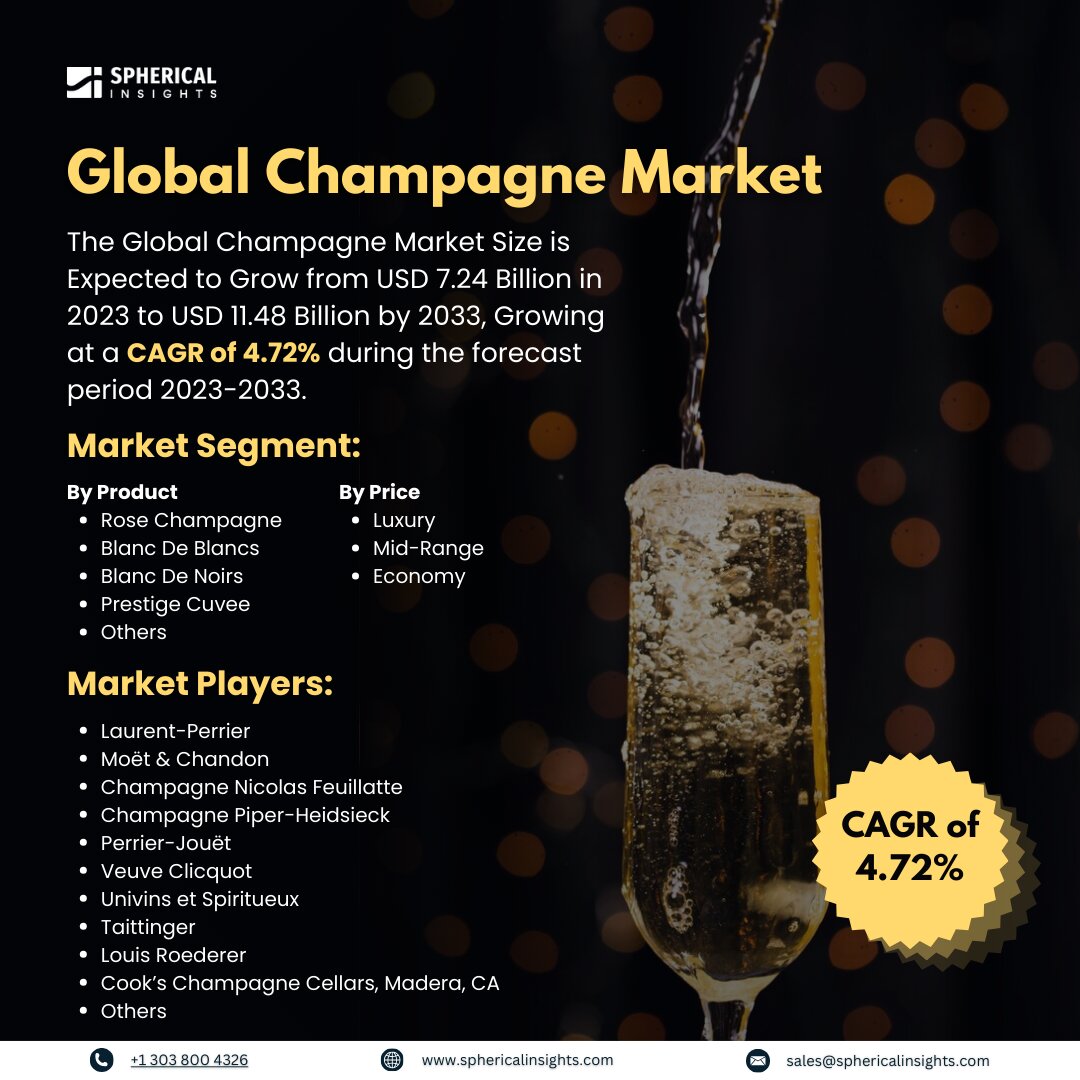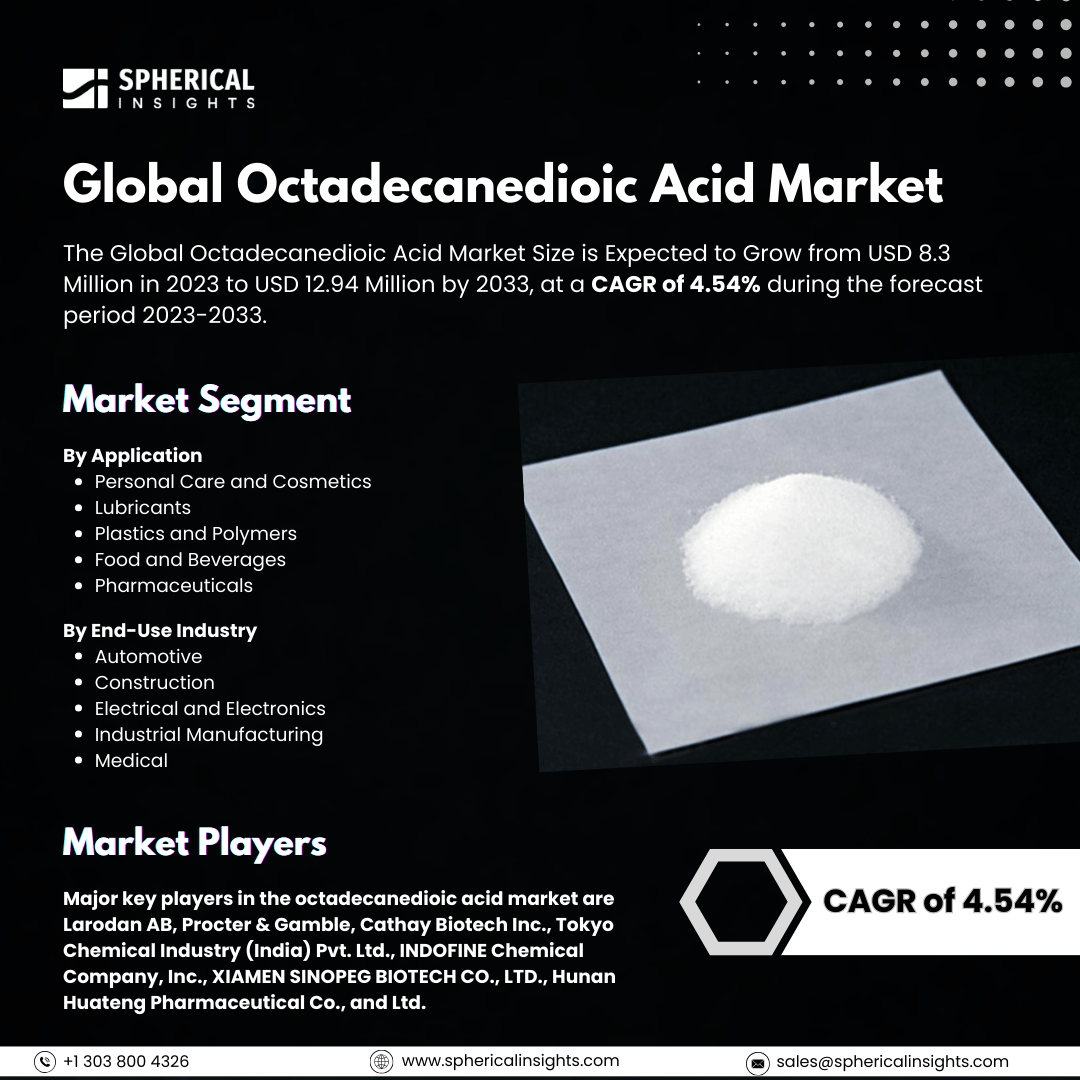Global Champagne Market Size to Worth USD 11.48 Billion by 2033
According to a research report published by Spherical Insights & Consulting, the Global Champagne Market Size is Expected to Grow from USD 7.24 Billion in 2023 to USD 11.48 Billion by 2033, Growing at a CAGR of 4.72% during the forecast period 2023-2033.
Browse key industry insights spread across 215 pages with 110 Market data tables and figures & charts from the report on the Global Champagne Market Size, Share, and COVID-19 Impact Analysis, By Product (Rose Champagne, Blanc De Blancs, Blanc De Noirs, Prestige Cuvee, and Others), By Price (Luxury, Mid-Range, and Economy), By Distribution Channel (On-trade and Off-trade), and By Region (North America, Europe, Asia-Pacific, Latin America, Middle East, and Africa), Analysis and Forecast 2023 – 2033.
Champagne is a sparkling wine that is made in France's Champagne region. Pinot Noir, Pinot Meunier, and Chardonnay are the primary grape varietals used in its production. The traditional technique of fermentation is used, which includes a second fermentation in the bottle to produce the distinctive bubbles. Owing to French law, which states that only sparkling wines made in the Champagne region may be referred to as Champagne, champagne is protected and is often associated with luxury and festivities. Previously used for special occasions such as weddings and accomplishments, champagne is presently being used for more relaxed get-togethers such as birthdays, office parties, and dinners. Additionally, the growing popularity of vintage wines and champagnes reflects consumer preferences for authentic flavors and experiences, which lead to a surge in demand. As premiumization continues to shape the alcoholic beverage market, especially in wine and spirits, Champagne's association with sophistication and luxury positions it for further growth. These changes in consumption patterns in Europe and North America, marked by an increase in food service establishments and casual drinking occasions, have had a significant impact on the market for champagne. However, smaller producers may find it challenging to compete effectively due to these high expenses, which could result in higher retail pricing for consumers.
The blanc de blancs segment is expected to hold the largest market share of the global champagne market through the forecast period.
Based on the product, the champagne market is categorized into rose champagne, blanc de blancs, blanc de noirs, prestige cuvee, and others. Among these, the blanc de blancs segment is expected to hold the largest market share of the global champagne market through the forecast period. A sparkling wine that is made entirely of white grapes is called a blanc de blancs. It has a bright aroma of citrus fruits such as grapefruit, lemon, and lime, as well as floral notes such as honeysuckle and white blossoms. Enjoy it as a celebratory drink or on its own as a lovely aperitif. For toasting and special occasions, its delicate aromas and crisp, refreshing character make it a popular option. Owing to its intense acidity and complex flavors, it complements a wide range of dishes. It enhances foods such as salads, sushi, shrimp, and seafood. Owing to its adaptability, it works well in both rich and light recipes.
The economy segment is anticipated to hold the highest market share of the global champagne market through the projected period.
Based on the price, the champagne market is classified into luxury, mid-range, and economy. Among these, the economy segment is anticipated to hold the highest market share of the global champagne market through the projected period. Since economy champagne is widely available and reasonably priced, customers can enjoy premium champagne. Champagne producers and houses are increasing their selection and launching more reasonably priced options in response to the rising demand. Since production is growing, economy champagne has become widely accessible in marketplaces worldwide. Furthermore, the expansion of champagne's geographical reach and its distribution to a larger audience is being facilitated by improvements in logistics and transportation. Economy champagne is also becoming more and more popular as a result of the growing practice of serving it at festivities and other events.
The off-trade segment is estimated to hold the highest market share of the global champagne market through the forecast period.
Based on the distribution channel, the champagne market is divided into on-trade and off-trade. Among these, the off-trade segment is estimated to hold the highest market share of the global champagne market through the forecast period. Off-trade channels such as supermarkets, liquor stores, and internet retail platforms make it simple and convenient for customers to purchase champagne. These retailers provide a wide range of champagne brands, varieties, and prices to suit the tastes and financial constraints of their clientele. Customers can sample many champagnes and find new favorites owing to this wide assortment. The need for off-trade channels is driven by this ease and variety.
Europe is expected to hold the largest share of the champagne market through the forecast period.
Europe is expected to hold the largest share of the champagne market through the forecast period. Champagne houses highlight the limited availability, legacy, and distinctive features of their products through focused marketing efforts. In order to appeal to affluent customers who appreciate high-end and genuine experiences, these initiatives showcase champagne's craftsmanship, terroir, and luxury positioning. Media campaigns, sponsorships, and partnerships with well-known events increase brand awareness and attractiveness. Brands of champagne are promoted and differentiated to maintain a strong market presence and increase customer demand.
Asia Pacific is predicted to grow at the fastest CAGR of the champagne market over the forecast period. The Asia Pacific champagne market has been greatly impacted by the growth of retail and e-commerce platforms. With a large assortment, thorough product details, and customer feedback, online retail platforms give customers an easy option to purchase champagne. The ability to purchase champagne online and have it delivered right to their house. Furthermore, champagne manufacturers can offer limited-edition items and exclusive products through direct-to-consumer channels, drawing collectors and aficionados and propelling the market's expansion.
Competitive Analysis
Major key players in the champagne market include Laurent-Perrier, Moët & Chandon, Champagne Nicolas Feuillatte, Champagne Piper-Heidsieck, Perrier-Jouët, Veuve Clicquot, Univins et Spiritueux, Taittinger, Louis Roederer, Cook’s Champagne Cellars, Madera, CA., and others.
Recent Developments
- In March 2024, Piper-Heidsieck announced that it would be the Official Champagne of the Miami Open for three years. Champagne variants such as Rosé, Cuvée Brut, and Riviera of Piper-Heidsieck are available for consumption by guests at the Champagne Garden during the two-week competition.
Key Target Audience
- Market Players
- Investors
- End-users
- Government Authorities
- Consulting And Research Firm
- Venture capitalists
- Value-Added Resellers (VARs)
Market Segment
This study forecasts revenue at global, regional, and country levels from 2023 to 2033. Spherical Insights has segmented the champagne market based on the below-mentioned segments:
Global Champagne Market, By Product
- Rose Champagne
- Blanc De Blancs
- Blanc De Noirs
- Prestige Cuvee
- Others
Global Champagne Market, By Price
Global Champagne Market, By Distribution Channel
Global Champagne Market, By Regional Analysis
- North America
- Europe
- Germany
- UK
- France
- Italy
- Spain
- Russia
- Rest of Europe
- Asia Pacific
- China
- Japan
- India
- South Korea
- Australia
- Rest of Asia Pacific
- South America
- Brazil
- Argentina
- Rest of South America
- Middle East & Africa
- UAE
- Saudi Arabia
- Qatar
- South Africa
- Rest of the Middle East & Africa



